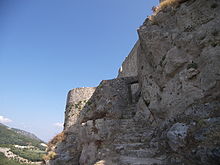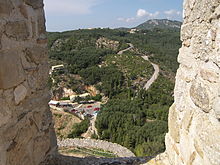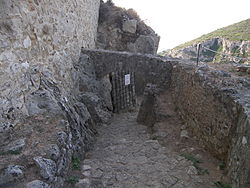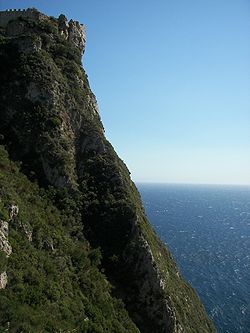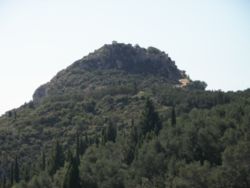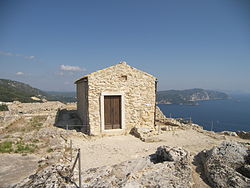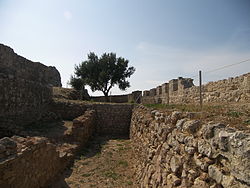- Angelokastro (Corfu)
-
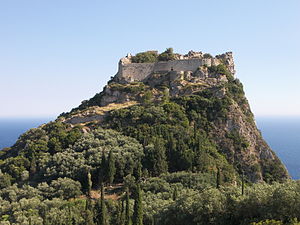 Front view of Angelokastro approaching from the nearby village of Krini. Archangel Michael's church at the Acropolis can be seen at the top left of the castle. The Ionian sea can be seen in the background. Remnants of the battlements can be seen on the right (northeast) side of the castle. The circular protective tower can be seen in front of the main gate.
Front view of Angelokastro approaching from the nearby village of Krini. Archangel Michael's church at the Acropolis can be seen at the top left of the castle. The Ionian sea can be seen in the background. Remnants of the battlements can be seen on the right (northeast) side of the castle. The circular protective tower can be seen in front of the main gate.
Angelokastro (Greek: Αγγελόκαστρο, English translation: "Castle of Angels" or "Angelos's castle") is one of the most important Byzantine castles of Greece. It is located on the island of Corfu at the top of the highest peak of the island's shoreline in the northwest coast near Palaiokastritsa (Greek: Παλαιοκαστρίτσα, English translation: "Old castle place") and built on particularly precipitous and rocky terrain. It stands 1,000 ft (305 m) on a steep cliff above the sea and surveys the City of Corfu and the mountains of mainland Greece to the southeast and a wide area of Corfu toward the northeast and northwest.[1]
The origin of its name is not completely clear, with some historians mentioning that in 1214 Michael I Komnenos Doukas, Despot of Epirus, sometimes called Michael Angelos, annexed Corfu to Epirus and following his death, Michael II Komnenos Doukas, often called Michael Angelos in narrative sources, further fortified the area and named it after himself and his father: Angelokastro.[2][3] The Despots were related to the Komnenoi dynasty of Byzantine emperors. Today foreign language tourist signs in the area refer to it, wrongly, as St. Angelo's castle.
Angelokastro is one of the most important fortified complexes of Byzantine Corfu. It forms an Acropolis, translated as city on the edge, that surveyed the region all the way to the southern Adriatic and therefore presented a formidable strategic vantage point to the occupant of the castle.[4] The engineering of its construction at such a remote and forbidding location is remarkable by any standards, not only medieval.
It played a pivotal role during the Great Siege of Corfu in 1571 when the Turkish attack on the northwestern flank of Corfu was successfully repulsed by the defenders of the castle.[1][2]
Contents
Origins and strategic significance
Situated at an impregnable and strategic position, Angelokastro became important to the island's fortunes for many centuries. In peace time it was also a centre of commerce and development. During excavations in 1997 by the Society of Byzantine Antiquities of Corfu, two Early Christian slabs were unearthed at the top of the acropolis, indicating that the site was occupied by the early Byzantine period (between 5th-7th century AD).[4] The Byzantines built the castle in order to defend the island from the attacks of the Genoan pirates.[3] Before the Venetians conquered Corfu there were three castles which defended the island from attacks: The Cassiopi Castle in the northwest of the island, Angelokastro, defending the west side of Corfu and Gardiki in the south of the island.[5] It is considered one of the five most imposing architectural remains in Corfu along with Gardiki Castle, the Kassiopi Castle built by the Angevins and the two Venetian Fortresses of Corfu City, the Citadel and the New Fort.[6]
Byzantium
It can be reasonably assumed that since Byzantium lost its dominion over southern Italy in 1071 AD, the Komnenoi must have paid a lot of attention to the castle since Corfu by default became the frontier to the west of the Byzantine Empire between the 11th and 12th centuries, serving to separate and defend Byzantium from its dangerous foes to the west.[4]
At the same time, the acritic and windswept fortifications helped safeguard Corfu from the great menace of that era, i.e. the Normans of Sicily whose constant incursions had turned the island into a theatre of military conflict.[4]
Architectural highlights
The castle's west, northwest and south sides are protected by the terrain that slopes precipitously.
Church of the Acropolis
The acropolis is located at the highest point with a church at the southern side. The church is dedicated to Archangel Michael and it is built at the site of an Early Christian three-aisled church.[4]
Circular tower
The main gate points to the north and is protected by a circular tower. The ruins opposite the main gate formed the garrison's quarters. There were three underground cisterns that supplied water to the castle occupants.[4]
Battlements survive only on the northeastern side of the castle. A small gate also existed at the southern side.[4]
Anthropomorphic graves
There is a cemetery on the western side with graves carved out of the rock in the shape of the human body as in a sarcophagus. The origin of the anthropomorphic graves has not yet been determined.[4]
Chapel in the rock
At the east side there exists a tiny chapel, dedicated to St. Kyriaki, that also served as a hermitage. The chapel was created by digging into the rock formation and as such it is a cave-like structure. There are paintings inside the chapel that date back to the 18th century.[4]
History
Angevins
After the Crusaders took Constantinople in 1204, Corfu fell into the hands of a variety of invaders until 1267 when it was occupied by the Angevins of Naples. Shortly thereafter the Angevins took over Angelokastro. The takeover is documented in a rare manuscript of the time confirming the change of ownership of the castle. The manuscript is the oldest written reference to the castle.[4]
Venetians
In 1386, the castle came under the ownership of the Most Serene Republic of Venice (Venetian: Serenìsima Repùblica Vèneta). Throughout the period of the Venetian rule the castle enjoyed great prominence because it offered protection to the locals from foes such as the Genoan pirates (Italiian Genovese) to the west as well as the Turks to the east. The Turks were never able to penetrate its defences.[4]
The Venetians, being the prominent maritime power of the era, used it to monitor the shipping lanes in the southern Adriatic and the Ionian sea. The Castellan (Venetian: Castellano) i.e. the Governor of the castle was appointed by the city of Corfu and was a nobleman whose family name was included in the Venetian originated Libro d'oro or Golden book, a list of the aristocratic families of Corfu.[4]
Under the dominion of Venice Corfu was defended throughout the period of her occupation. However invasions and associated destruction still occurred during this time, especially at the undefended areas of the island.[4]
Genoan piracy
In 1403, a Genoese pirate fleet made an attempt to occupy Angelokastro. The Genoan pirates burned and pillaged the surrounding area. Then they attempted to occupy the castle. After furious battles with the Corfiot garrison, they were ultimately repulsed.[2]
Turkish siege
In August of 1571, the Turks made another of many attempts at conquering Corfu. Having seized Parga and Mourtos from the Greek mainland side they attacked the Paxi islands, killing, looting and burning. Subsequently they landed on Corfu's southeast shore and established a large beachhead all the way from the southern tip of the island at Lefkimi to Ipsos in Corfu's midsection of the eastern part of the island. These areas were thoroughly pillaged and burnt as in past encounters. Nevertheless the city castle stood firm.[2]
The Turks also attacked Angelokastro at that time trying to establish a beachhead at the northwestern part of the island.
The Corfiot garrison at Angelokastro stood firm.[2] These Turkish defeats both at the city castle in the east and Angelokastro in the west proved decisive and the Turks abandoned their attempt at conquering Corfu. Angelokastro protected the population of the region again during the second Great Siege of Corfu by the Turks in 1716.[7]
Modern times
With the advent of modern warfare the castle's importance declined and gradually it fell into a state of disrepair.[4] The passage of time did to the castle what no aspiring conqueror could. From 1997, however, the Corfu chapter of the Society of Byzantine Antiquities of Greece has undertaken a restoration programme under the co-sponsorship of the Greek Ministry of Culture and the European Union.[4]
The castle has been closed to the public for the duration of the excavations and the reconstruction that started in 1997 and will continue well into 2008. As of 25 May 2009 the castle was open with an admission fee of 2 Euros, but like most of the Greek cultural sites on the Island it is closed on Mondays.
References
- Notes
- ^ a b Stamatopoulos, Nondas (1993). Old Corfu: history and culture (3 ed.). N. Stamatopoulos. pp. 325. http://books.google.ca/books?id=6m0-AQAAIAAJ&q=Angelocastro&dq=Angelocastro&hl=en&ei=TJuwTvzvCur00gHmhNy-AQ&sa=X&oi. "From the top of Angelocastro the view sweeps far and wide over the hills across the breadth of Corfu, to the town, the Eastern Channel and the mountains on the mainland, over a sheer drop of a thousand feet to the sea below"
- ^ a b c d e History of Corfu
- ^ a b Corfu: history - monuments - museums A. B. Tataki Ekdotike Athenon S.A., 1985 - History - 160 pages p.20 p.69
- ^ a b c d e f g h i j k l m n o Information notice board of the Society of Byzantine Antiquities of Greece (Corfu Chapter) at the Angelokastro site
- ^ Greek traditional architecture Volume 1 Dēmētrēs Philippidēs Melissa, 1984 p.222
- ^ Corfu and the other Ionian islands by Martin Young Cape, 1977 - 357 pages p.108
- ^ Old Corfu: history and culture by Nondas Stamatopoulos, 1993 - Architecture - 325 pages p.165 Quote: "In 1571, when they once more invaded Corfu, the Turks again unsuccessfully attacked, Angelocastro, where 4000 people ... During the second great siege of the city by the Turks in 1716, Angelokastro once again served as a refuge for the..."
Categories:- Castles in Greece
- Corfu
- Byzantine archaeological sites in Greece
- Byzantine forts
Wikimedia Foundation. 2010.

